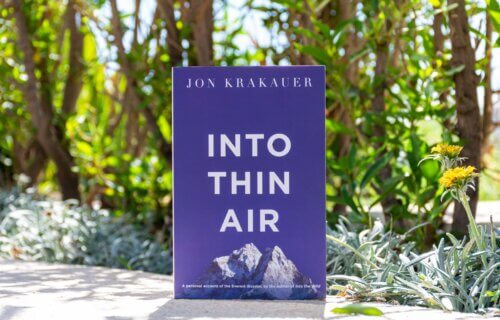Narrative non-fiction attempts to present facts in a way that is both exciting and accurate to events. The best examples of this genre transport readers to the frontlines, so to speak, and allow them to experience fantastic events firsthand. Our list of the top seven best narrative non-fiction titles could lead readers to discover their next exciting page-turner.
Who says no one reads paper books anymore? A new study finds your local public library may be the hottest place to be in town. Researchers from data and analytics group WordsRated looked at nearly 17,500 libraries over the last three decades and found that these institutions aren’t dying in the digital age — they may actually be thriving. Although visits to U.S. libraries have dropped by 21 percent since 2009, there are actually more people borrowing books than ever before.
Another great advantage of borrowing library books is that many parents find that their favorite childhood books are available and ready to share with their kids. A new study finds Americans are getting nostalgic for the books of their youth. More than half of Americans (54%) say they transport themselves back to their childhoods by reading their favorite books as kids — including 62 percent of people over 77 years old. The survey also found that half the poll respondents still claim to remember every line from their favorite children’s book, with millennials the most likely to say so.
Narrative non-fiction is an exciting subgenre that is full of best-sellers. Personal tales of strength, perseverance, and in some cases, dumb luck pepper these intriguing stories of human struggle and conflict. Our sources helped us find the best narrative non-fiction titles and rank them for review. Let us know your favorite narrative nonfiction titles in the comments below!

The List: Best Narrative Non-Fiction Books, According to Experts
1. “Killers of the Flower Moon” by David Grann (2017)
“Killers of the Flower Moon” recounts an infamous story of violence in the American west. This book takes readers 100 years back in time to confront racism and injustice. Books List Queen notes, “David Grann investigates the fascinating case of the Osage murders in the 1920s. After discovering oil on their land, the Osage Indian Nation in Oklahoma are among the richest people in the world at the time. Once the death toll surpasses 24 Osage, the newly created FBI takes up the investigation to expose an alarming conspiracy behind these notorious crimes.”

BookBub praises, “Grann contextualizes one of the most devastating and horrific conspiracies in American history against Native Americans. Including new information and evidence, he writes about the FBI’s investigation into the 1920s mass killings of members of the Osage Nation in Oklahoma and how these killings were related to the oil boom of the Wild West.”
“In the 1920s, Oklahoma [recognized] members of the Osage Indian nation [as] some of the wealthiest people per capita in the world, due to the oil fields beneath their land. A ‘Reign of Terror’ by white people intent on getting some of this wealth included shooting, poisoning, and bombing in order to decimate the tribe,” exclaims Madison Public Library.
2. “Into Thin Air: A Personal Account of the Mount Everest Disaster” (1997) by Jon Krakauer
This book is the harrowing account of an intrepid mountain climber. Things do not go according to plan, and the story that is recounted is a terrifying tale. Shepherd says, “Jon Krakauer lives to tell and write the tale of two misguided climbs up Mount Everest taking place the same weekend in May 1996. He’s there on a magazine assignment that morphs into a powerful book about bravery and also the hazards of hubris.”

Celadon Books describes, “‘Into Thin Air’ is his first-hand account of the climb that claimed five lives and left countless more forever changed. Haunted by the experience and consumed by guilt over the deaths, Krakauer reports in heartbreaking detail the tireless efforts of the Sherpas, the mistakes that proved fatal, and the calamitous storm that descended upon the group.”
Everyday Reading elaborates, “After being sent to report on the tourist industry of Everest, Jon Krakauer recollects one of the deadliest seasons recorded on Mt. Everest. He recounts his own personal trauma and the recollections of the other surviving members of the expeditions. This is a truly harrowing and gripping book.”
3. “Hidden Valley Road” by Robert Kolker (2020)
“Hidden Valley Road” is a heart wrenching story of mental illness. There are no definitive answers in this best-selling classic. Penguin Random House comments, “Don and Mimi Galvin seemed to be living the American dream… But behind the scenes was a different story: psychological breakdown, sudden shocking violence, hidden abuse. By the mid-1970s, six of the 10 Galvin boys, one after another, were diagnosed as schizophrenic. How could all this happen to one family?”

Books List Queen adds, “Shortly after World War II… The tale of an American family who became the center of most of our current research on schizophrenia, ‘Hidden Valley Road’ has become one of the top nonfiction books of 2020.”
BookBub details, “By learning about what the family went through, including controversial therapies and contributions to DNA research still in use today, readers will gain a deep appreciation for how the understanding of mental illness has shifted towards greater awareness, knowledge, and hope.”
4. “The Emperor of All Maladies” by Siddhartha Mukherjee (2010)
This is the story of confronting what is known about cancer, and the history of this knowledge. It may be difficult for some to read, as it details the physical and emotional tolls of the disease. Lit Hub explains, “‘The Emperor of All Maladies’ won the 2011 Pulitzer in General Nonfiction… But most importantly, it was the first book many laypeople (read: not scientists, doctors, or those whose lives had already been acutely affected by cancer) had read about the most dreaded of all diseases, and though the science marches on, it is still widely read and referenced today.”

BookBub offers, “A blend of science, history, and literary exposition, Mukherjee’s book is a brilliant and poignant demystification of cancer. Crafting a compelling narrative by looking at case studies and historical records, he takes us back centuries into the past to examine how people have dealt with this insidious disease, underscoring how much we’ve learned and how far our treatments have progressed.”
Celadon Books states, “Physician and author Siddhartha Mukherjee unfurls the history of cancer in this Pulitzer Prize–winning work that merges in-depth science writing with vivid storytelling. Mukherjee draws on more than five centuries’ worth of data to chronicle cancer’s presence, documenting the death tolls, medical breakthroughs, and declarations of war on the malady.”
5. “The Immortal Life of Henrietta Lacks” by Rebecca Skloot (2010)
This book is about the scientific exploitation of cell cultures taken from Henrietta Lacks. It is a story of science-driven profit. BookBub claims, “Not many people know of Henrietta Lacks: She’s been gone for decades, yet her legacy exists in the form of ‘immortal cells’ that scientists found in her body and took without her consent to use for research and experiments. Skloot digs deep into the story, grappling with the knowledge that Lacks and her family were struggling to make ends meet while scientists profited off her cells and turned their discoveries into a billion-dollar industry.”

Everyday Reading relates the details of this book, “During [Lacks’] treatments, doctors took samples of her tumors and discovered her cells were ‘immortal.’ Scientists call these cells HeLa cells, and they changed the future of medicine and science. Covering three intertwined stories: the science behind HeLa, the legal issues around consent and ownership of cells, and the story of the Lacks family, this book truly is fascinating.”
Lit Hub reviews, “Skloot set a wildly ambitious project for herself with this book. Not only does she write about the (immortal) life of the cells as well as the lives of Lacks and her (human, not just cellular) descendants, [but] she also writes about the racism in the medical field and medical ethics as a whole.”
6. “Hillbilly Elegy” by J. D. Vance (2016)
Life in America is depicted as a struggle in this bestseller. Vance writes about poverty and the struggle to prosper and pursue happiness. “So much more than simply a memoir, ‘Hillbilly Elegy’ is an evocative and thoughtful cultural exploration of white working-class Americans. From postwar struggles to the difficulty of upward mobility, this is a familiar and haunting tale of the American dream and a crucial look at the United States at this point in time,” according to Off the Shelf.

Books List Queen assures, “it’s about his family life in Southwestern Ohio and how the Hillbilly culture and ethics his grandparents brought from rural Kentucky affected the lives and choices of his grandparents, parents and even himself… While you might not agree with all of Vance’s conclusions, he has certainly started a conversation, forcing readers to ponder how culture affects us and what heritage you will pass down to your children.”
Bookbub articulates, “It’s an insightful look at how the sociopolitical circumstances of a large chunk of the country can influence American politics, and, as New York Times columnist David Brooks raves, it’s ‘essential reading’ for all of us.”
7. “In Cold Blood” by Truman Capote (1965)
“In Cold Blood” is the granddaddy of narrative nonfiction. This hard-hitting story takes some liberties with the details but delivers a compelling narrative. Off the Shelf compliments, “The true crime classic that perfected and popularized the narrative nonfiction genre (and sparked debates about the importance of accuracy in nonfiction), Truman Capote wove a chilling and moving account of the shocking murders of the Clutter family.”

BookBub asserts, “Capote’s true crime classic transcends the genre and has left generations of readers haunted by its contents. ‘In Cold Blood’ sheds light on the mysterious, brutal murder of a family in Holcomb, Kansas, as Capote patches together what few clues were found and launches his own investigation.”
Books List Queen evaluates, “Through extensive interviews from the first days on the scene and following the events all the way to the execution of the murderers, Capote suspensefully unfolds the whole story of exactly what happened and more intriguing of all, why it happened. Make sure you set aside a chunk of time to read this modern classic because, I promise, once you start, you’ll realize this is a book you can’t put down.”
You might also be interested in:
Sources:
- Books List Queen
- BookBub
- Madison Public Library
- Shepherd
- Celadon Books
- Everyday Reading
- Penguin Random House
- Lit Hub
- Early Bird Books
- Off the Shelf
Note: This article was not paid for nor sponsored. StudyFinds is not connected to nor partnered with any of the brands mentioned and receives no compensation for its recommendations.

Endurance by Alfred Lansing should have made the list.
Yes great book.
Endurance is a great book, my personal favorite.